Stone Age to Iron Age
About the first people to live in the Kirklees area
The first people to visit Kirklees arrived around 10,000 years ago. They arrived after the last Ice Age, which had gone by about 8,300 BC. From that point, the temperature rose and there was less rainfall. Alder, birch, hazel, oak, elm and lime trees replaced the previous cold-resistant plants, and provided resources for the first arrivals to the area. This period became known as the Mesolithic period - or Middle Stone Age.
Mesolithic
The first people to arrive lived in dwellings which were hunting camps, high in the Pennines between Marsden and Saddleworth. The landscape would have been mainly grasslands and woods. We can recognise these camps from burnt patches and scatterings of flint, used for spears, arrows and tools. Flint is a hard, glass-like rock found in chalk. It does not occur naturally around Huddersfield, so it must have been brought here, probably from East Yorkshire.
A Mesolithic site near Marsden that has shown high integrity deposits, including artifacts that indicate people were sitting around hearths and making arrows over 6,500 years ago.
Neolithic
The first farming communities settled in Huddersfield around 5,000 years ago. We use archaeological finds such as polished stone axes and arrow heads as evidence. This period is known as the New Stone Age - or Neolithic. At Castle Hill, Almondbury, there is evidence of settlement from the Neolithic period. Excavations have found Late Neolithic flint tools and a polished stone axe, suggesting the area was in use before the first hill-fort was built.
Bronze Age
After around 1,500 BC, England entered a period now called the Bronze Age. During this time, bronze, an alloy of copper and tin, was used for making tools. An oval enclosure above Denby Dale is likely to be Late Neolithic or Early Bronze Age, and finds include flint scatter. Four burials have also been found on Pule Hill, Marsden, which seems to have been a Bronze Age cemetery of around 1,500 BC. As the climate began to deteriorate around 1,000 BC, some land became unsuitable for farming, so defences were built to protect those that already existed. During this time, defences were built around Castle Hill.
Iron Age
Iron was introduced around 700 BC, and this period became known as the Iron Age. Castle Hill became the dominant settlement in the area, as more banks and ditches were added to give mulitple lines of defence. The Brigantes were a Celtic tribe who arrived in Britain by the early Iron Age. They controlled a large area of northern England, and were living in small farming communities, with no towns. The farmers grew crops and reared animals.
What to expect in the box
Some of the items in this box are very sharp and delicate.
Please be extra cautious when handling.
From around 50 BC - 50 AD, this Iron Age mirror is highly decorated and has a shiny reflective surface.
The original was found in Desborough, Northamptonshire, and is Celtic in style.
A mirror would have been a powerful object in a world where reflections could only be glimpsed in water. A person using a mirror would control how they looked using the mirror in combination with tweezers or shears. Decorated mirrors of this type are uniquely British, very few are found in Europe.
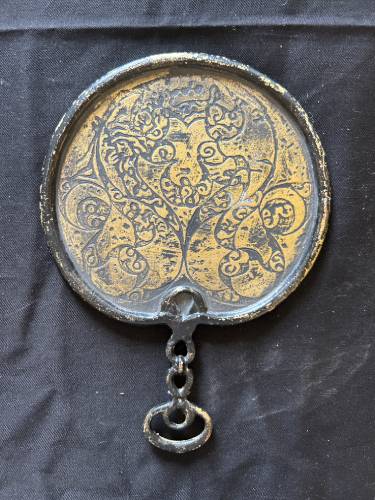
This is believed to be the world's oldest map of the stars, and is around 3,600 years old - dating from the Bronze Age. It was discovered by archaeologists in Germany, alongside axes and swords.
The disc shows the Sun, moon and stars (single and in constellation), and can highlight how this was central to religious beliefs at a time when people were worshipping the heavens and aligning their monuments to the sunrise, such as Stone Henge.
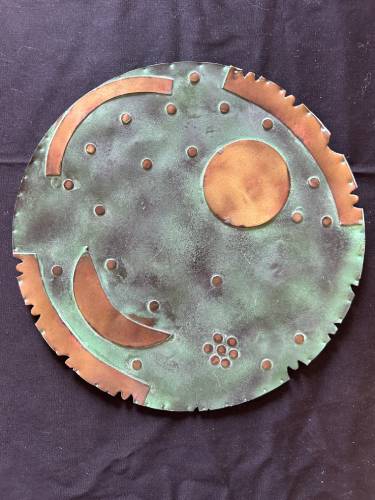
The bark from the birch tree could be used to make storage vessels and cooking pots.
This container would be used for storing grain or berries. During the neolithic period, hunter-gatherers would collect fruit, berries and nuts as they travelled, and stored this to eat when supplies were low.
As people began to settle around 4000 BC, farming for pulses, barley and wheat became a common practice. Grains would be stored for use in winter.
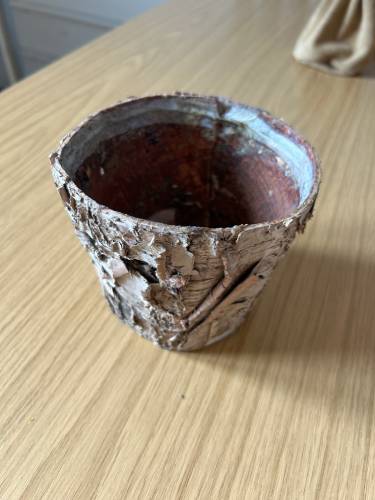
Stone Age people started making jewellery not long after they started making weaponry. Their jewellery included beads on necklaces and bracelets, pendants and hair pins.
They made these beads from shells, animal teeth, animal bones, stones and chalk. They would then thread these beads onto string often made from plant stems or thin strips of animal hide. They would even sometimes decorate their jewellery by carving designs into the bead's surface.
Engraved chalk objects can be traced throughout the Neolithic period, as it offers surfaces that can be smoothed, allowing designs to be sketched, reworked, altered or erased accordingly.
This pendant is a replica of one found on the WhitehawkWoman in Brighton, in a Neolithic Causeway Enclosure.
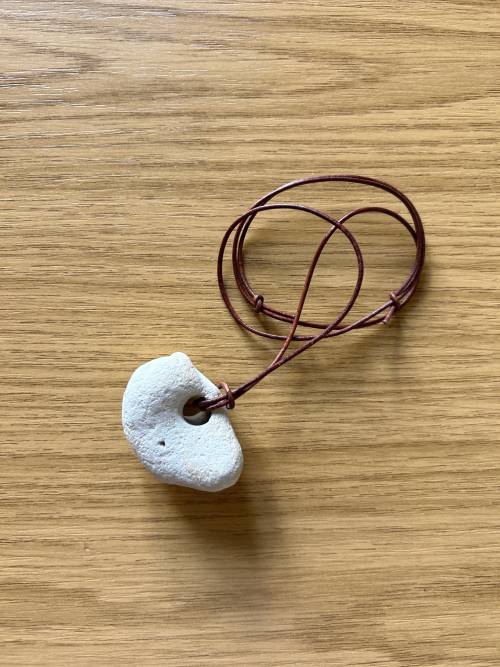
Baltic amber has been used for art work and ornamentation since the Mesolithic, and would have been highly prized.
It would be used for jewellery, animal figurines and cups.
Amber is a fossilized tree resin, formed when tree bark resin hardens and loses its liquids.
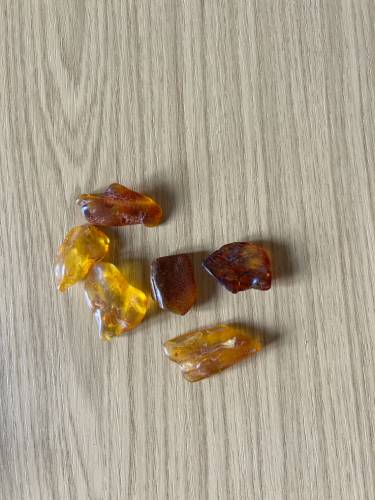
A looped palstave axe was at the leading edge of tool design in the middle to late Bronze Age (1300 - 1100BC).
The bronze head would have originally been cast in a two part stone mould. Then it would be attached to a wooden haft (handle), made from a branch.
Tools such as these would have been important for hunting, and gathering wood for fires.
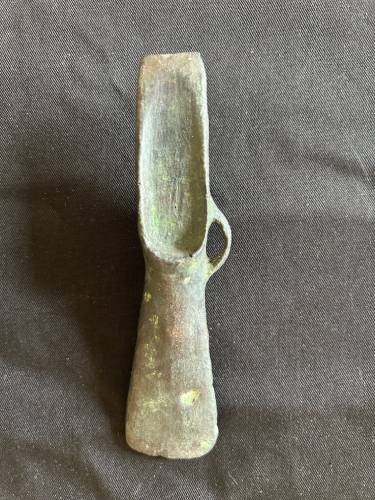
Wild boars lived in a variety of habitats in the pre-historic period, including dense woodlands all over England.
Cave paintings often depict wild boar, and they were among the most desired hunting prey from Mesolithic and Neolithic hunters and human burial sites from this period include jewellery made from boar tusks and teeth.
They could have had a symbolic use, showing the wearer's hunting prowess, or they could have been quite practical, such as being used for preparing fish for cooking.
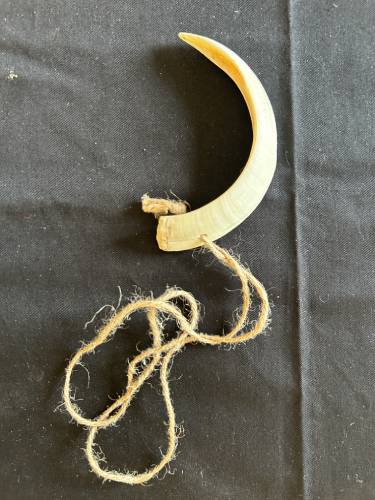
Pottery bowls have been around since before the Neolithic period, with some dating back to 29,000BC.
Bowls with flat bases were used to sit on fires as cooking pots, or for storing food in the floor.
The function of broad, shallow bowls of this type could include the separation of cream from milk, the preparation of solid foods or kneading dough.
Bowls of this type date from around 400 - 100 BC.
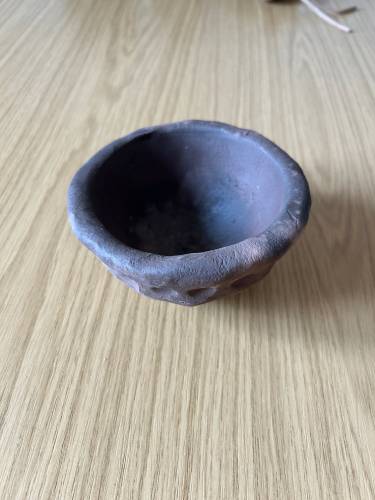
Dress pins were made from animal bone and bronze in the Bronze Age.
These pins are thought to have been used to fasten clothing or for holding up hair.
In the Bronze Age, people moved away from just wearing animal hides, to using wool. Leather was used as straps on clothes and shoes. Most clothing was a dark colour, or dyed using natural dyes.
Both men and women in the bronze age wore knee-length gowns with one or two shoulder straps. Men wore cloaks around their shoulders.
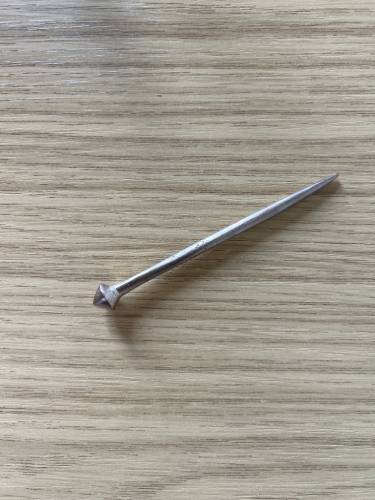
Flint knives have been used by humans since the Stone Age and have been found in archaeological sites dating back over 800,000 years.
Flint knives were used for a variety of purposes, including cutting meat, preparing animal skins, and possibly religious ceremonies.
Flint knives were made from flint found on the ground, which could be cut without breaking it.

Bronze spearheads were used from around 1700BC throughout the Bronze Age, which lasted from 2000 BC to 700 BC.
They were weapons that could be used in battle, to display status, or as ritual objects.
To use a bronze spearhead effectively, it wasm ounted on a long wooden shaft and secured with loopheads.
This spearhead is made from a cast of the original item found at Denshaw, near Manchester.

These arrowheads are known as 'dove tails' due to their shape.
They were probably made for hunting and cutting meat from large animals, and many examples show multiple re-sharpening, suggesting their use as a knife.
They date from the early Neolithic period.
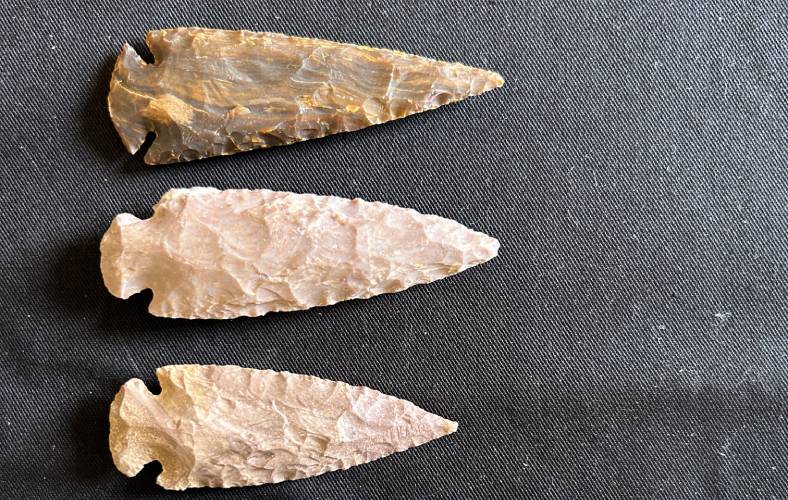
Antler harpoons have been found in Mesolithic caves and rock shelters.
One example is a harpoon head made from red deer antler that was carbon dated to around 4500 BC.
This is cast from the original harpoon found in Victoria Cave, Settle. This barbed harpoon point is made from deer antler. It dates to around 11,000 years ago and it probably arrived in the cave embedded in a scavenged or dying animal that had been hunted by the first known inhabitants of the Yorkshire Dales.
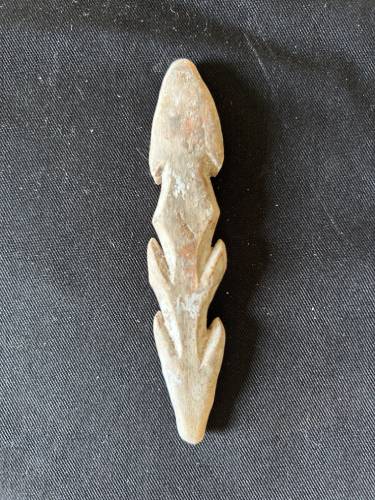
Flint axes were tools used by hunter-gatherer groups during prehistoric times for a variety of tasks, including farming, butchery, and occasionally as weapons.
This was cast from the original from Tooter Hill, Bacup. There are some small mounds and earthworks on Tooter Hill, which are considered to be a long lost Neolithic settlement.
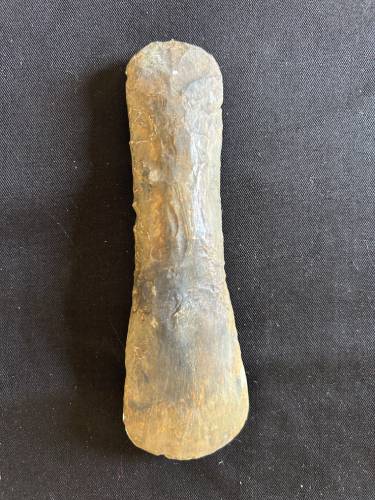
Stone axes were first made by farming communities between 6,000 and 4,000 years ago. The earliest stone axes with full grooves are thought to have been made around 9,000 to 8,000 years ago.
Stone axes were used for many purposes, including chopping, carving, and splitting wood. They were also used to clear forests to create agricultural land.
These are cast from the originals found at Langsett, Todmorden and Cawthorne.
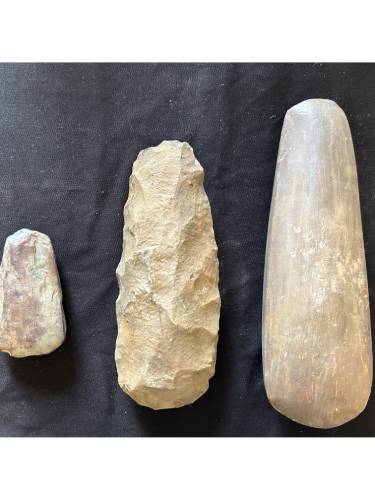
Antler axes were made and used from the Upper Palaeolithic to the Bronze Age. The durability and shock resistance of antler makes it suitable for axes, though it lacks the cutting power of flint.
These are cast from the original objects found at Star Carr, Scarborough and Calf Hole Cave, Thresfield.
Star Carr is a Mesolithic (Middle Stone Age) archaeological site, dating to around 9000BC, just centuries after the end of the last Ice Age. There was considerable evidence for antler and bone working tools.
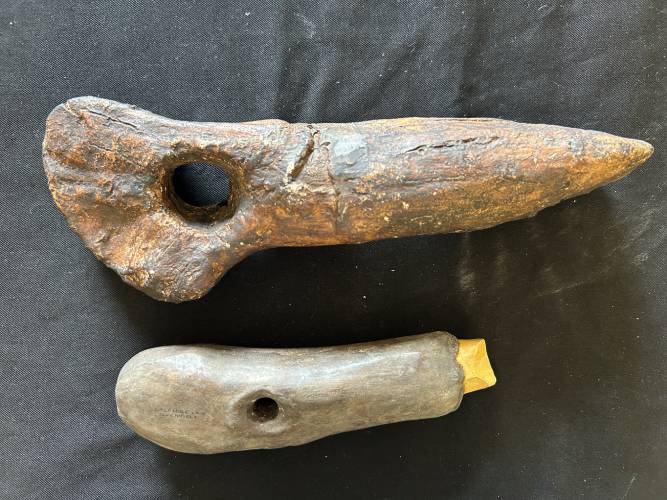
Flint axes have a long history, dating back to prehistoric times when they were used by hunter-gatherer groups.They were originally just sharpened pieces of flint, but eventually came to be used with wooden handles.
These are cast from the originals found at Ringstone Reservoir and Horbury. They date from the Neolithic period.
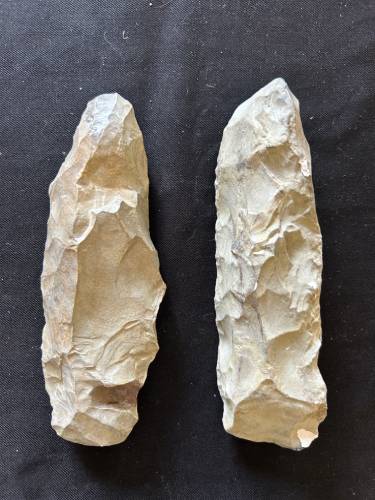
Flint knives have been used by humans since the Stone Age and have been found in archaeological sites dating back over 800,000 years. They would be used for cooking, cutting wood, and hunting.
Neanderthals were the first humans to use flint knives, which they made from flint found on the ground's surface.
These are cast from the originals found at Swineshaw Moor, they date from 2055BC-1650 BC.
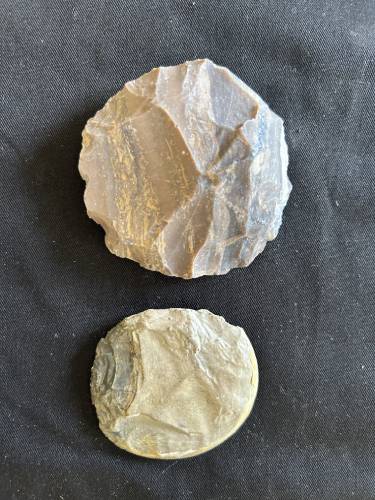
Explore the following themes using the objects
- Innovation
- Technology
- Religion and beliefs
- Daily life
- Social change
- Manufacturing
- Natural materials
- Hunting
- Warfare
- Animals




